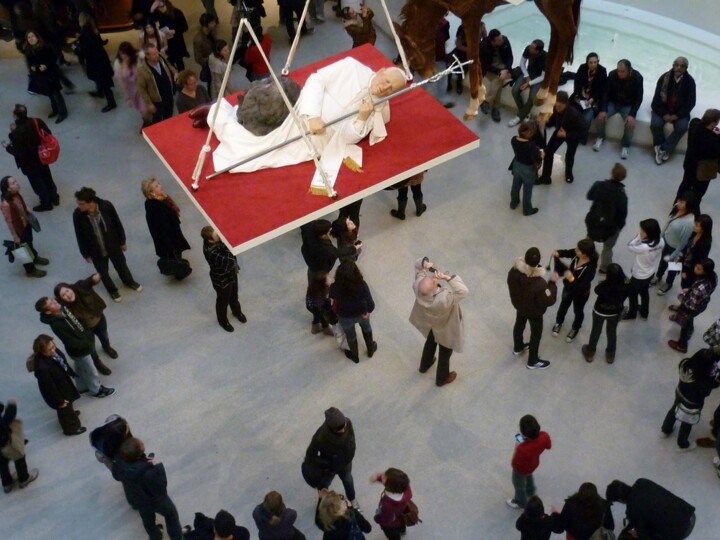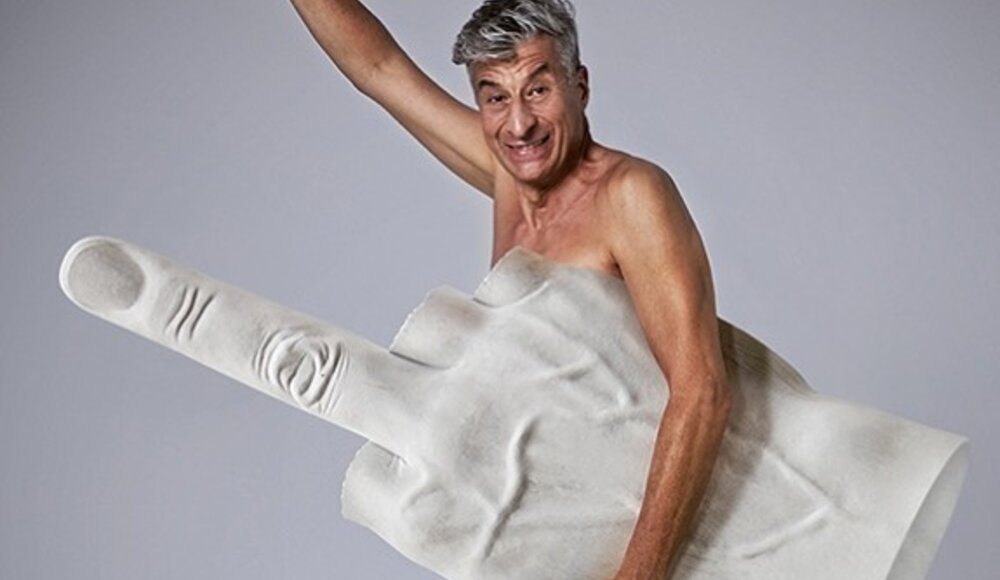Artists have long collaborated with uncredited assistants to create their works. Contemporary artists have pushed this even further since the 1960s, with the advent of Minimal and Conceptual art, contracting fabricators to create works to their technical specifications. The art world has long held that the work's sole author is the mastermind behind its conceptual and intellectual underpinnings. A recent French lawsuit involving the works of Maurizio Cattelan has effectively supported this line of thought—and established a legal precedent in France.
A panel of three judges ruled earlier this month in Paris against sculptor Daniel Druet, who sued to be recognized as the sole creator of Cattelan's nine hyper-realistic wax effigies, including La Nona Ora (1999), depicting Pope John Paul II struck down by a meteor, and Him (2000), depicting Adolf Hitler as a kneeling child. Cattelan was not initially named as a defendant in Druet's lawsuit, which was filed against Cattelan's gallery, Perrotin; Turenne Éditions, Perrotin's publishing imprint; and Monnaie de Paris, which displayed some of the works in 2016. Druet sought "fair credit" as the sole author of these nine sculptures, as well as financial "compensations" in addition to the $272,814 he had already received for the nine works he created.
 La Nona Ora (1999), Maurizio Cattelan, photo: Mark B. Schlemmer from New York, NY, USA - Guggenheim NOV2011 Cattelan 5
La Nona Ora (1999), Maurizio Cattelan, photo: Mark B. Schlemmer from New York, NY, USA - Guggenheim NOV2011 Cattelan 5
"It is with great pleasure that I learn of this decision, which enshrines Maurizio Cattelan's work as a conceptual artist and rejects in every way the inadmissible and unfounded arguments of Daniel Druet," the gallery's founder, Emmanuel Perrotin, said in a recent statement. "I am overjoyed that this decision brings to an end a controversy that has threatened a large number of contemporary artists." Druet's unexpected strategy in his suit was to file against everyone except Cattelan, the true target of his copyright infringement complaint. To avoid potential losses, the Monnaie de Paris attempted to make Cattelan a party to the lawsuit, which it was successful in doing through a legal maneuver known as impleading.
Cattelan was thus "bond[ed]" to the Monnaie de Paris in the event that the court ruled against him. He ended up being involved without ever really being involved, which is ironic given that the artist has made a career out of playing hard to get. "It is extremely surprising that Mr. Druet did not only fail to sue Mr. Cattelan directly but also failed to adjust tactics along the way," Julie de Lassus Saint-Geniès, an intellectual property expert who has closely followed the case but was not directly involved in either party's legal representation, said in an interview. Perrotin attempted to raise a procedural issue to dismiss the case at this stage on the grounds that the wrong people were being sued, with the help of law professor Pierre-Yves Gautier and criminal attorney Pierre-Olivier Sur. The court, however, decided that rather than simply ruling on the procedural issue, it would delve deeper and proceed with the suit in order to resolve the copyright infringement claims in some way.
"The Court's refusal was a blessing in disguise: we got to win on substance rather than a procedural technicality," Sur, a former president of the Paris Bar Association, , adding that he was amazed at the turnout to hear the panel of judges issue their ruling. (The final hearing was held in the largest courtroom of the Tribunal Judiciaire de Paris.) Druet's second strategy, which was also rejected by the court, was to claim exclusive authorship over the nine sculptures he created for Cattelan, despite the fact that La Nona Ora, Him, and the other seven works were all exhibited, promoted, and written about (in catalogues and the press) under Cattelan's name. "Authorship shall belong, unless proven otherwise, to the person or persons under whose name the work has been disclosed," according to the French Intellectual Property Code. Furthermore, according to the recent ruling, Druet claimed that "he gave birth to the litigious works, breathed life and intensity into them, without receiving, for some of them, any instruction from Mr. Cattelan."
According to the judge's ruling, Perrotin's representation submitted to the court several examples of explicit instructions given by Cattelan to Druet. Cattelan had sent Druet a "prose poem" in addition to the technical specifications for each sculpture, which reads, in part, "I wonder: If when I was little, I could have imagined it [La Nona Ora] in its current condition." "I'm so tired of being tired..." On December 1, 2000, Cattelan wrote to Druet about the Him sculpture, saying, "The most important thing is that the final result must be a hyperrealistic face with an ecstatic expression as if communicating its future mission in this moment of devotion." Hand position: the hands must be thinner and hairless [...] Hitler's head must be tilted slightly lower..."
"It was also up to Druet to bring elements to refute Cattelan's legal presumption, not the other way around," said former Pierre-Yves Gautier student de Lassus Saint-Geniès. Furthermore, Druet admitted in the decision that he had nothing to do with the "precise directives" for how the works were installed, "particularly with regard to their positioning within the exhibition spaces, aimed at playing on the public's emotions (surprise, empathy, amusement, repulsion, etc.), were issued only by [Cattelan]." The Court's focus on the installation of Cattelan's works resulted in a brand-new definition in French law that takes into account both the materialization and display of a work of conceptual art.
"In order to determine fair crediting and compensations, the creative input of a set designer or even a museum curator should be studied more carefully before drafting a contract," de Lassus Saint-Geniès said. According to De Lassus Saint-Geniès, the new judgment confirms French precedent established in two previous cases, both of which laid the groundwork for a better understanding of conceptual art: Jakob Gautel vs Bettina Rheims, in which the installation of a work involving golden letters helped Gautel win against Rheims, and the Alberto Sorbelli case, which made a performance subject to copyright.
Sur, Perrotin's legal counsel, believes the new ruling will be taught in French law schools in the future: "In the first year of law school, you are introduced to the Poussin and Renoir judgments [related to attribution and co-authorship issues]." There is now the Perrotin decision." And Druet has the option of suing Cattelan directly. "The real question in a rematch would be whether the litigious sculptures qualify as works of joint authorship." Will Druet be able to demonstrate that his artistic contribution extends beyond the simple execution of the nine effigies?" Lassus Saint-Geniès stated
"There is precedent now," Sur added, "so I am fairly confident that Mr. Druet would still not win." Druet now has a month to decide whether to appeal the judgment to France's highest court or accept the ruling and pay the plaintiffs' legal fees: $10,125 to Perrotin and Turenne Éditions and $10,125 to Monnaie de Paris.


 Jean Dubreil
Jean Dubreil